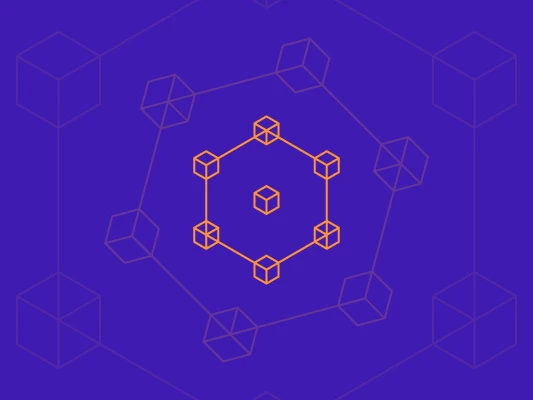
What Is Blockchain Technology
Blockchain technology is a distributed digital ledger that stores data of any transactions. Blockchain redefines the way we transact, from finance and healthcare to education, logistics, digital media, and beyond. However, it’s most well-known as the technology that underpins cryptocurrencies, providing a secure, decentralized ledger for transactions and ownership tracking.
So how exactly does blockchain work, and what are its real-world applications?
Join us in our extensive breakdown of blockchain technology and find answers to all your questions.
Key Takeaways
- Blockchain is a distributed ledger that securely records and stores transactions using cryptography
- Blockchain technology has several advantages over traditional databases, such as transparency, immutability, traceability, security, and censorship resistance
- Blockchain redefines the way we transact, from finance and healthcare to education, logistics, digital media, and beyond
- Cryptocurrencies and NFTs are two of the blockchain’s most common use cases.
What Is Blockchain?
Blockchain technology is a decentralized digital ledger that stores all transactional data in chains of blocks — hence the name “blockchain.” These blocks hold records, with each block carrying a cryptographic hash of the previous block to ensure that the chain of blocks remains unbroken.
Blockchain is an immutable distributed ledger that records transactions and tracks assets within a business network.
Blockchain technology has several advantages over traditional databases, where the data stored is under the control of a central authority, such as:
- Immutability. Blockchain is a type of distributed ledger technology (DLT) that supports immutability – it remains permanent, unaltered, and indelible and prevents data tampering within the network. Each of the blocks of information is carried out with the help of an immutable cryptographic signature called a hash, meaning it is impossible to erase or replace recorded data. Every block in the chain must be altered to corrupt a blockchain system.
- Transparency. Network participants can trace data recorded into the blockchain, making trading on the blockchain secure and transparent.
- Traceability. Blockchain allows easy tracing of the transaction chain. It is possible to trace the distributions of nodes and hash rates, product origin, and supply chain activities, as well as identify counterfeits or fake transactions.
- Censorship Resistance. Blockchain technology is free from the censorship of any single authority (including governments), so no party can prevent a transaction from going through.
- Security. Blockchain helps prevent fraud and unauthorized activity, as well as address privacy issues by storing data across a network of computers rather than a single server. The entire network won’t be compromised even if a blockchain copy appears in a hacker’s hands.
Blockchain Technology History
Early Years (1991-2004)
The idea of blockchain technology was introduced by research scientists Stuart Haber and W. Scott Stornetta in 1991. They developed the system of storing data cryptographically and time-stamping it so it can’t be tampered with. In 1992, Merkle Trees expanded on the idea and formed a secure chain of blocks to store data.
No significant developments happened till 2000, when Stefan Konst developed the theory and implementation of cryptographically secured chains. Konst was followed by Hal Finney, who came up with a digital currency based on “Reusable Proof of Work.”
Bitcoin Blockchain (2004-2009)
The breakthrough was in 2008 when a mysterious entity named Satoshi Nakamoto published a whitepaper titled “A Peer-to-Peer Electronic Cash System.” In 2009, Satoshi Nakamoto published the Bitcoin whitepaper and invented blockchain technology through the Bitcoin blockchain. James Howells participated in the first Bitcoin mining in 2009.
Blockchain technology has been evolving ever since.
How Does Blockchain Technology Work?
Blockchain technology stores data in blocks, which are connected, forming a chain. The stored data is encrypted using cryptographic hash technology that converts it into an irreversible string of characters. Whenever new information enters the network, the network members verify it and add the data to the blocks once it’s verified.
Blockchains act as digital ledgers used for recording transactions. Any participant can view and verify the transaction record in the entire database. Since no centralized authority controls the distributed database, blockchain technology is considered a truly decentralized network.
Blockchain technology uses various consensus mechanisms to verify the stored data. Two of the most commonly used consensus mechanisms are Proof-of-Work (PoW) and Proof-of-Stake (PoS). Bitcoin blockchain works on the PoW consensus mechanism, in which blockchain transactions are verified using the network users’ computational powers through a process called mining. On the other hand, in 2022, the Ethereum blockchain shifted from PoW to a PoS consensus mechanism, in which staked ETH tokens are used to validate transactions. The advantages of Ethereum’s PoS mechanism over the Bitcoin network are higher energy efficiency, scalability, and transaction throughput.
Users interact with a blockchain and its network through a blockchain platform. Blockchain platforms act as extensions from an existing blockchain infrastructure, allowing services and information exchange to be powered directly from this framework.
Different Types of Blockchain
Over the years, different types of blockchains have been developed, including:
Public Blockchain
In a public blockchain network, anyone can view and verify the transactions and information stored on it. The public blockchain was the first type of blockchain to come into existence. The Bitcoin blockchain is a public blockchain where anyone can become a node to mine BTC and verify data. Public blockchain networks are primarily used for storing data about monetary transactions.
Private Blockchain
A governing entity controls who can join and access the network in private blockchain networks. Blockchain users need permission from the private blockchain network administrator to join the network. In these networks, the governing authority controls every aspect of the network, such as security, functioning, transaction records, etc. These networks are used mainly by private corporations and companies. The IBM blockchain is an example of a private blockchain.
Hybrid Blockchain
In a hybrid blockchain network, the best aspects of public and private blockchain networks come together. Hybrid blockchain networks store the transaction record privately but can still be verified. The governing authority can grant access to users wishing to become network members. Unlike the public blockchain, the user’s identity is kept secret and only disclosed to members with whom they complete financial transactions. The network owner can also select the transactions and data they wish to make public.
Consortium Blockchain
A blockchain consortium is a network of private blockchains interacting and working with each other. These networks are used mainly by businesses and companies wishing to work together. In this network, each private network forms a node and is controlled by the organization it belongs to. The information stored on the consortium can be accessed by all the other members or nodes. To make any changes in the information or how the consortium network functions, permission from all the nodes is required.
Sidechain
A sidechain is a blockchain built on a parent blockchain known as the mainnet. Sidechains can be built over any type of blockchain network and are used to scale the existing networks and bring about additional functionalities, i.e., easing asset transfers, etc. Sidechains are not to be confused with blockchain layers; visit our article “What Are Blockchain Layers” to learn more about them.
Blockchain Technology Use Cases
Blockchains have come a long way in a short span of time. And with each passing day, the technology is moving closer to gaining mass adoption as new use cases emerge. Some of the most popular uses of blockchain technology are as follows:
Conduct Transactions
Blockchain technology was invented to replace the existing financial institutions in the backdrop of the 2008 global financial crisis. Bitcoin was the first digital currency built on blockchain, and since then, thousands of digital assets have emerged that can be used for making financial transactions such as payments, staking, lending, borrowing, etc.
To make financial transactions using blockchain technology, you must have a cryptocurrency wallet to store digital assets. Each crypto wallet has a public key, i.e., the wallet address and private key, to access the wallet. Users must also pay transaction fees in the form of the blockchain’s native token to make transactions on blockchains. For e.g., ETH is used to pay fees when a transaction occurs on the Ethereum blockchain, whereas BTC is required for Bitcoin transactions.
Cryptocurrency Exchanges
Cryptocurrency exchanges are built on the blockchain and can be used to buy and sell digital assets. Most exchanges also offer advanced trading features such as derivatives and margin trading.
Fast Fact
You need a crypto wallet with a private and public key to transact on the blockchain. And if your private key is lost, it becomes impossible to recover your digital assets.
Crypto Lending and Borrowing
Decentralized finance is one of the most innovative uses of blockchain technologies that remove the need for a middleman or a third party to control financial services. Through DeFi, anyone with a crypto wallet and internet connection can undertake crypto lending and borrowing on blockchain platforms. The entire process is completed using automatically executing smart contracts and takes only a few seconds. A smart contract is a code that contains pre-approved conditions and is used by a large number of blockchain protocols and blockchain applications.
Real Estate
Real estate transactions can be cumbersome and time-consuming, involving much paperwork. However, blockchain applications used to verify the information and proof of ownership and for transferring deeds and titles make the process automated and secure.
Data Security
Today, when almost every aspect of our digital lives are governed using data, the safety and security of user data are paramount. A blockchain protocol to store and manage data makes it secure and difficult to tamper with. The decentralized database built on a blockchain platform removes the issue of a single point of failure, thereby removing the risk of data corruption, hacks, cyber-attacks, etc. It also comes in handy when protecting sensitive information such as electronic medical records.
Government Schemes and Services
Governments can streamline the delivery of goods and services to citizens using blockchains. They can also use blockchain technology to track product supply chains more accurately. Moreover, governments worldwide are exploring options for creating their own Central Bank Digital Currency (CBDC) using blockchains.
Non-Fungible Tokens (NFTs)
NFTs have taken the world by storm. Besides being digitalized artworks, NFTs can be used to tokenize any real-world asset, making it easy to transfer and difficult to steal.
Conclusion
Blockchain is an emerging technology with significant advantages. The development of blockchain applications has been ongoing even during crypto winters when the price of Bitcoin and other cryptocurrencies is in decline.
What makes blockchain important and game-changing is the possibility of decentralized trading in complete confidence without any controlling authority or intermediary. Blockchain transactions are traceable, secure, and immutable.
While there are some shortcomings such as the unregulated nature of the crypto industry, the immense potential of the entire blockchain is yet to be discovered. If you’re interested in diversifying your portfolio, investing in blockchain technology and cryptocurrencies can be one of your best investment opportunities.
Disclaimer: This article is purely for educational purposes, and nothing in it should be considered a piece of financial advice.






